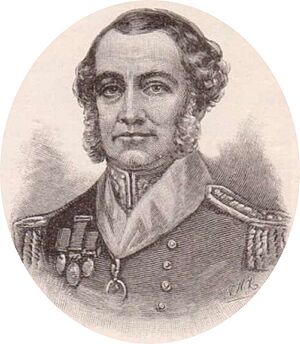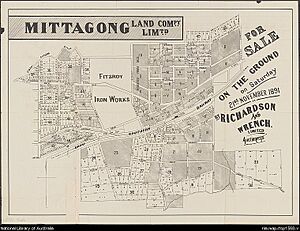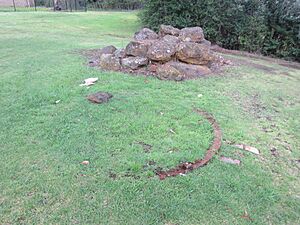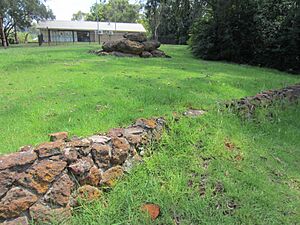Chalybeate Spring, Mittagong facts for kids
The Chalybeate Spring in Mittagong, New South Wales, was a special natural spring. Its water was fizzy and full of iron.
For thousands of years, these iron-rich springs in Mittagong helped create a large deposit of iron ore. This ore was later mined by the Fitzroy Iron Works. This factory was very important in the early days of Mittagong, a town in the Southern Highlands of Australia.
The spring was also a popular place for visitors, especially from the mid-1800s to the early 1900s.
Contents
Discovery and Early Days
The Gandangara people were the first owners of the land around Mittagong. We don't know if they used the spring for water. Its strong taste and earthy smell probably made it less appealing than the fresh water nearby. However, the iron-rich soil around the spring might have been used to make ochre (a natural pigment).
European settlers likely found the spring around 1833. This was when a surveyor named Jacques noticed iron ore in the area. He was working on a new road to Berrima.
In January 1849, Governor Charles Augustus FitzRoy visited the spring. He named it 'Lady Mary's Well' after his wife, who had passed away. But this name didn't really stick. Most people continued to call it 'The Chalybeate Spring'.
For a while, people thought it was the only chalybeate spring in New South Wales. But there were actually others nearby, and even more springs within Mittagong itself.
What the Spring Was Like
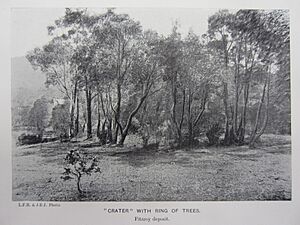
The Chalybeate Spring was on a small grassy hill. It was about 400 meters from the Mittagong railway station, on the south side of the main road (now Old Hume Highway).
In 1896, it was described as "just a little hole in the ground" where water seeped out through cracks in the iron ore. Later, the spring water came out of a pipe.
Geological Surveyor J.B. Jaquet described how these types of springs looked naturally. He said they often came out of "saucer-like depressions" (like small craters) on top of low mounds. These mounds were made of material brought up by the water. He explained that the spring might change its path if the opening got blocked.
The water was naturally fizzy and full of iron. It was said to have "an inky taste and an earthy odour." The water looked clear at first, but it would turn rusty after a few hours. People believed it had "medicinal properties" because the small amount of iron in it was good for the body.
The spring's flow rate wasn't directly measured. Around 1901, there were three active springs in the area. The largest one, probably the Chalybeate Spring, was estimated to flow at about 455 liters per hour.
Why the Spring Was Important
Iron Ore Deposit
The spring's water looked clear but turned rusty after a few hours. This happened because when the iron-rich water met the air, the iron would separate and settle. Over about 30,000 years, this process created a large deposit of limonite, a type of iron ore, at Mittagong.
This iron ore was quite rich, with 44% to 57% iron. The total amount of ore on the Fitzroy land was estimated to be 150,000 tons.
The geological surveyor J.B. Jaquet described the ore. He said some of it was powdery and yellow to deep red, called "oxide." The other part was compact and dark brown. It often contained pieces of plants and sand that got trapped as the ore formed.
This iron ore deposit led to the creation of the Fitzroy Iron Works in 1848. This was Australia's first commercial iron factory. It is seen as the start of Australia's iron and steel industry.
In the 1800s and 1900s, the "oxide" from Mittagong was also used to clean town gas by removing harmful gases.
During World War II in 1941, there was a shortage of ships. It made sense to mine local iron ore in New South Wales instead of bringing it from South Australia. The Mittagong ore was small but close to a railway line to the Port Kembla steelworks. About 14,000 tons of ore were mined near the spring that year.
Tourist Attraction
Even though it was near an iron mine and factory, the Chalybeate Spring became a popular tourist spot from the mid-1800s.
Around the time Governor FitzRoy visited in 1849, people were already thinking about making the spring a place for visitors. It was said that "sick people from Sydney" could benefit from the waters and the fresh air. After the Governor's visit, the water was tested. Experts advised drinking it as soon as it came out of the spring.
In 1884, Edward Larkin improved the spring area. He worked for the Mittagong Land Company, which owned the land. He added a pipe to make it easier for visitors to get the water.
The spring was one reason why a railway station was built in Mittagong. An 1889 railway guide mentioned that Mittagong had several chalybeate springs. One, near the town, flowed into a brick well for visitors.
The spring's water became very well known. A newspaper in 1909 said the spring was popular all day long. People praised its "curative and invigorating properties." Many doctors even told their patients to visit Mittagong just to drink the spring water.
In 1921, a newspaper described the spring's facilities. It said the spring was enclosed with "summer-houses and seats." There were also places for visitors to rest, picnic, and get refreshments. The local Tourists' Association worked hard to make the spot comfortable and attractive.
Decline and Disappearance
By 1938, mineral springs were no longer as popular. The Chalybeate Spring in Mittagong slowly faded from public memory.
The iron ore mine and the spring had existed side-by-side for many years. The mining in the 1800s was small. But in 1941, more iron ore was mined near the spring. Even though people promised to protect the spring, this mining caused the Chalybeate Spring to change its location.
The land where the spring was located was always privately owned. In 1945, the local council was asked to approve building poultry sheds there. By 1948, the spring was "now enclosed in a fowl run." However, in 1962, it was still possible to collect water for testing.
By 1986, the RSL Club in Mittagong owned the land. In 1986, the club sold the land to the Wingecarribee Shire Council at a low price. The area around the spring became the Mineral Springs Reserve. A small museum, the Mineral Springs Historical Centre, was built to remember the Fitzroy Iron Works.
In October 1988, a visitor noted that the "healing" waters of the 'Lady Fitzroy' mineral spring had been "retapped." The spring water was "freely available to all, flowing continually from a brass tap."
The Mineral Springs Historical Centre was open for less than a year in 1988. It's not clear exactly when the spring stopped flowing.
In 2005–2006, parts of the Fitzroy Iron Works were found during construction of a shopping mall. These remains are now kept safe within the mall's carpark. This shifted the focus of remembering the iron works to the north side of the Old Hume Highway. This might have made the Mineral Springs Reserve seem less important.
In 2010, the council changed the land use for the Mineral Springs Reserve. In 2011, an application was made to divide the land. The former museum building became the Wingecarribee Aboriginal Community Cultural Centre in 2012. The other part of the land was planned for the Mittagong RSL Club. It still looks like parkland today.
What's Left Today
There's a sign near the entrance to the Mittagong RSL Club that tells about the spring and the land's history. The nearby Springs Resorts, owned by the RSL Club, are named after the old spring.
There is still a lot of iron ore on the south side of the Old Hume Highway. This ore was deposited over thousands of years by the chalybeate springs. Some parts of the hillside are rust-colored, and you can see ironstone rocks.
The Fitzroy Iron Works, built to use this iron ore, was very important for Mittagong's growth. It also left its own history and remains.
At the top of the hill, in the old Mineral Springs Reserve, you can still find a pile of ironstone rocks, some rusty concrete, stonework, and old brickwork. These are what's left of the last version of the Chalybeate Spring. The spring, as it was in 1988, no longer exists.
A little further down the hill, there's a low wall and a patch of ground that is always wet. Just above the wall, a small, soggy mound of iron oxide has formed. It's covered in green grass, and water still oozes from it. This might be all that remains today of the once-famous Chalybeate Spring.



